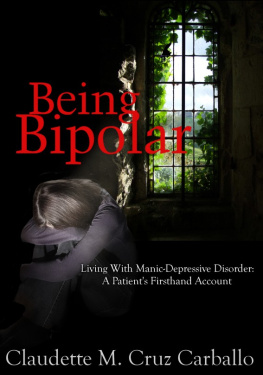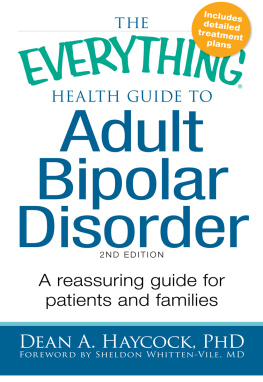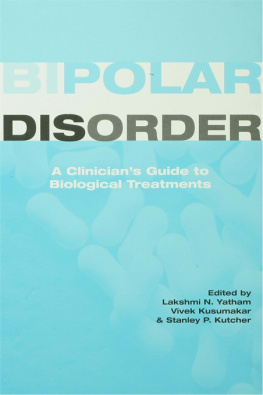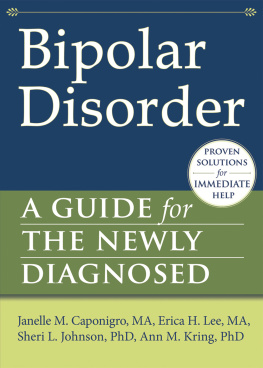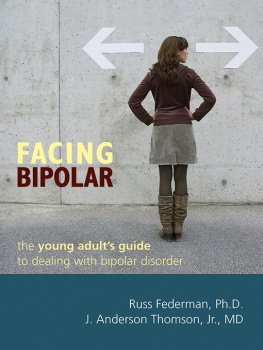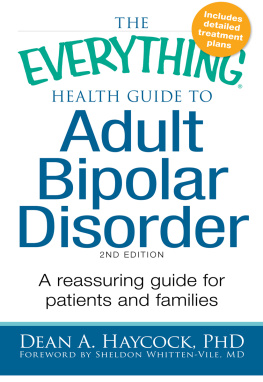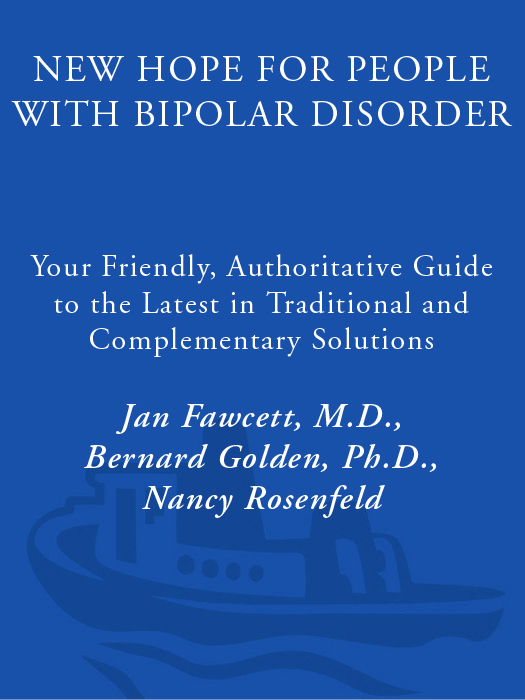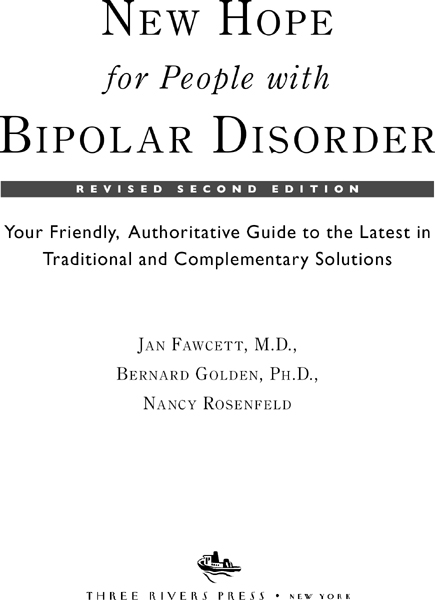A LSO BY J AN F AWCETT
Dynamics of Violence
Springhouse Physicians Drug Handbook, 8th Edition
Textbook of Treatment Algorithms in Psychopharmacology
Psychopharmacology and Psychotherapy: Strategies for Maximizing Treatment Outcomes, Vol. 1
Anhedonia and Affect Deficit States
The Encyclopedia of Mental Health
Manic-Depressive Illness, 2nd Edition
A LSO BY B ERNARD G OLDEN
Healthy Anger: How to Help Children and Teens Manage Their Anger
Unlock Your Creative Genius
A LSO BY N ANCY R OSENFELD
Just as Much a Woman: Your Personal Guide to Hysterectomy and Beyond
Unfinished Journey: From Tyranny to Freedom
I dedicate this effort to my familyto my wife, Katie, and my children, Robin, Holly, Marc, Andrea, and especially my son Craig, who struggled to have a meaningful life despite experiencing much of what this book is about, and who died in his sleep on July 29, 2007. I am grateful to his wife, Shauna, and his daughters, Brittany and Amber, for the love and moments of pride and joy they gave him during the last years of his life.
DR. JAN FAWCETT
Acknowledgments
T his book was Nancy Rosenfelds idea. The first time I met Nancy, she outlined her idea for a book about coping with bipolar disorder and asked me to write a chapter on diagnosis. I supported the idea of a book by someone who had experienced this illness, and agreed. The next thing I realized, I had written this and three more chapters.
Somehow Nancy had convinced me to become a coauthor along with Bernie Golden, whom I met and enjoyed working with in the course of producing the book. How did this happen? Nancy, the person who carries the stigmatized diagnosis, brought together, cajoled, and motivated two other people, with somewhat different perspectives but a common interest in reducing stigma and increasing awareness and hope with regard to bipolar disorder, to write this book.
Perhaps this is an example of the creative energy and determination that goes way beyond the concept of bipolar illness (this book wouldnt have happened without it). This is the lesson behind the message of the book. A person can become so much more than their illness. Ive made two new friends and I hope our work will help people with bipolar illness and their families become informed consumers of services and see the possibilities for productive and meaningful lives.
J AN F AWCETT
Completing this book marks the end of an extremely rewarding journey and collaboration. I am extremely grateful to Nancy Rosenfeld for inviting me to participate in this project. I thank her for her vision and courage. I am appreciative of her determination, commitment to quality, and for the many moments of personal joy I experienced as part of this team. Nancy started with a story and finished with a true message of hope. My deepest appreciation goes to Dr. Patricia Robin for her thoughtful consideration and confidence in recommending me to Nancy.
A special thanks to Jan Fawcett for his enthusiasm, knowledge, energy, and sense of calmness and centeredness that he brought to this endeavor. Frederick K. Goodwin, who spent countless hours reading and rereading our manuscript, also offered invaluable feedback, encouragement, and support.
Martha Hellander, executive director of Child and Adolescent Bipolar Foundation ( CABF ) provided us with parent interviews. This proved to be an invaluable source of material for , A Special Concern: Childhood/Adolescent Bipolar Illness.
My friends and colleagues listened to my ideas and offered critical feedback and encouragement. I also want to express my gratitude to Three Rivers Press for their enthusiastic confidence in the value of this book.
Finally, my sincere appreciation to all the clients who have shared their journeys with me.
B ERNIE G OLDEN
From first conception, the writing of this book was a team effort and could not have been achieved without everyones total commitment. I wish to thank my coauthors, Jan Fawcett and Bernie Golden, for their dedicated help, abiding loyalty, and steadfast willingness to go that extra mile. The strength of our teamwork could best be compared to a healthy and successful marriage. I recall a comment that I made to my coauthors at one meeting, If this is work, who needs entertainment?
A book of this nature, one that touches every aspect of the human soul, would have been impossible for me to author had it not been for the love and understanding of my husband, Marty. His patience was tested on many occasions, but each time he responded with unwavering loyalty and support.
I am deeply grateful to Frederick K . Goodwin for his substantial contribution. Besides providing the foreword, Dr. Goodwin offered indispensable critical feedback and guidance. It was his intention from the very beginning that this book meet all standards of professional excellence. His tome, Manic-Depressive Illness (Goodwin/Jamison), reached ultimate acclaim by the Association of American Publishers: Most Outstanding Book, Bio-and Medical Sciences, 1990.
Deborah Bullwinkel, former program director of National Depressive and Manic-Depressive Association (DMDA), now the Depression and Bipolar Support Alliance ( DBSA ), introduced me to several key people when I first began this book venture. National DMDA became an invaluable source of research material and information throughout the writing of this book. A special thanks to the staff!
Finally, my most sincere appreciation to Three Rivers Press / Random House for giving us the opportunity to move forward with this revised second edition. The suggestion originated from Carrie Thornton, publishing manager, whose proposal was based on the success of the books 2000 release, and Brandi M . Bowles, our editor, who carefully checked and rechecked all revisions and additions. Thank you both!
N ANCY R OSENFELD
Foreword
B ipolar illness has long been a source of fascination in the mental health field. The fascination stems from the dramatically different states of mania and depression, which are alternating components of the same illness yet often occur simultaneously; the sudden and dramatic processes by which intense depression becomes mania literally overnight, as if a switch had been turned on; the challenge to understand how the same drug (lithium) can bring mania down and lift depression up; and, finally, the paradox that in bipolar disorder, arguably the most genetic and therefore the most biological of all mental illnesses, the psychosocial environment appears to activate the genetic vulnerability, converting it into a lifelong illness.


